Jamie and I played a Spanish versus Swedes match up of Tilly’s Very Bad Day. In a very exciting game my Spanish eventually prevailed. We introduced a house rule to make chequerboard more effective and both focused on this aspect of the game with some interesting conclusions.
Version of Tilly’s Very Bad Day
We played Tilly’s Very Bad Day (version 1.1) with some experiments:
- We used Terrain Cards – Random terrain placement for pick up wargames
- To address the weakness of chequerboard deployment units suffered a -1d6 in melee if unsupported. Support meant any friendly unit to rear within 2 TUM.
- We also stretched the victory conditions so the winner had to inflict 33% loses on the enemy rather than just 25% loses. In our case six units out of 16.
Armies
We took 16 units in each army. I took a dragoons unit and an extra cannons unit. There is a pattern in my group to minimise cannons and dragoons as neither are perceived as super effective. Of course I wanted to test this further.
Spanish
- Right Wing
- 1 x General
- 1 x Horse
- 1 x Dragoons
- 1 x Cannons
- Centre
- 1 x General
- 6 x Pike+shot
- Left Wing
- 1 x General
- 3 x Horse
- 1 x Cannons
Jamie took pike+shot and horse instead of the extra cannons and dragoons.
Swedish
- Right Wing
- 1 x General
- 5 x Horse
- Centre
- 1 x General
- 4 x Pike+shot
- 1 x Cannons
- Reserve
- 1 x General
- 3 x Pike+shot
Terrain
We used Terrain Cards – Random terrain placement for pick up wargames. I’d knocked up some cards earlier that day and done a few trials. Based on this I changed the system so when Jamie arrived I was still gluing new faces to the terrain cards.
Although Jamie was the attacker I let him choose the terrain because it didn’t really matter. We wanted a small game so Jamie selected four terrain cards: Stream, Large Wood, Large Difficult Hill, Small Gentle Hill.

The terrain cards translated directly to terrain on the table top. And then we added a road. Jamie placed this along the seam between my terrain boards.

Deployment
I used a conventional deployment with two wings and a centre. I put the wing with the dragoons on the right flank with the woods. I put my cavalry wing on the left. My infantry centre was in chequerboard to benefit from the house rule about support.

Jamie massed his cavalry into his right wing. His infantry was also in chequerboard but he did this differently to me. He had two commands with the reserve as a second line behind the centre.
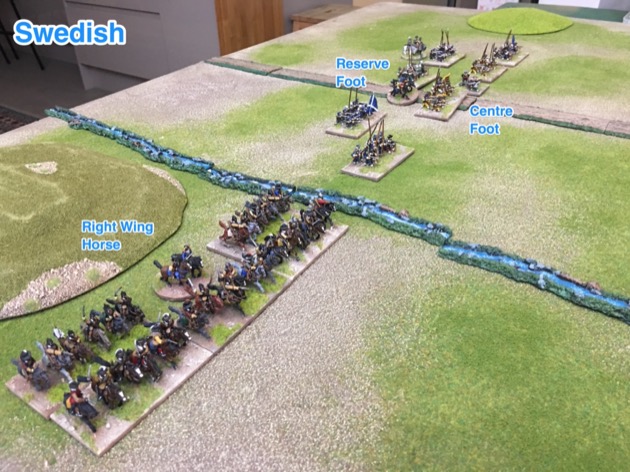
That was going to make an interesting match up in the centre. Which variation on chequerboard would win the day.

My small cavalry wing was going to have a tough time against the big Swedish right wing.

The battle
The Swedish advanced.

The most scary bit was the speed at which the Swedish cavalry roared forward.
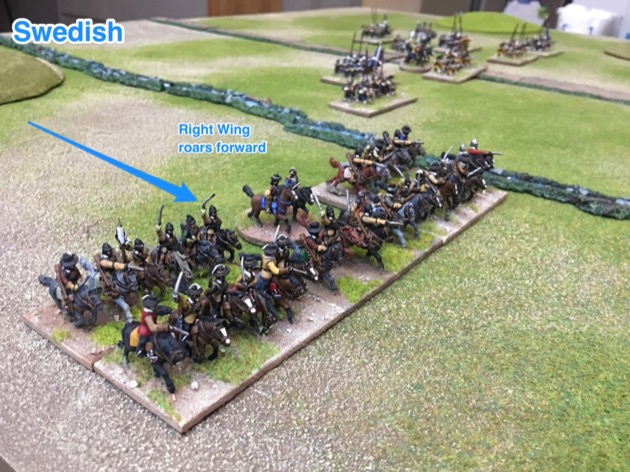
My own Spanish horse contracted their frontage to brace for impact. Meanwhile the Spanish cannons near the stream began to pound the Swedish cavalry steadily.

My right flank was held by a combined arms force. Dragoons, cannons, and (although not in the photo) horse provided by the right wing itself. Plus pike+shot from the centre command. I felt like I should have the advantage here.
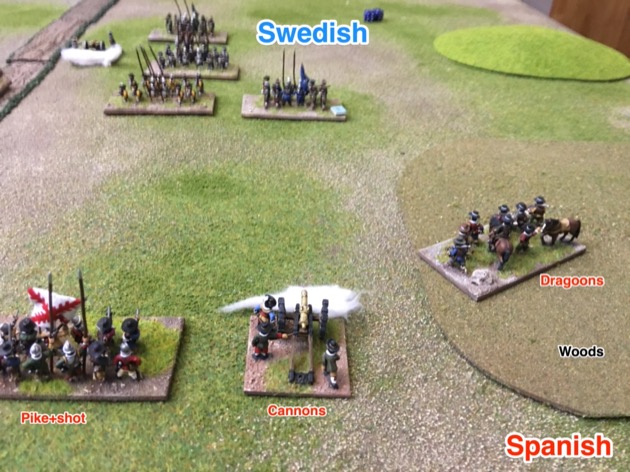
The muskets in the centre started blazing away. Jamie shot with both his lines. I held the fire of my second line as I wanted them to charge.

In the centre I withdrew some pike+shot units that were shooting and advanced my second line units to charge.

A Swedish pike+shot unit routed between the road and the wood.

Nothing major happened between the road and the stream.


Beyond the steam, on the Spanish left, Jamie had 5:2 odds. It didn’t look good for my Spanish.
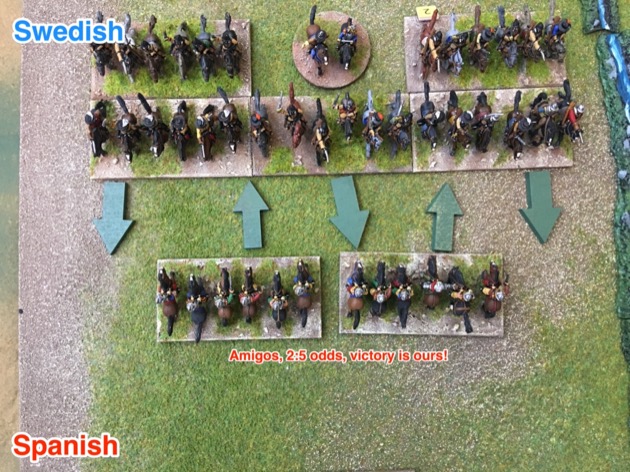
I lost a unit of horse straight out. But Jamie lost his general. And that would make all the difference.
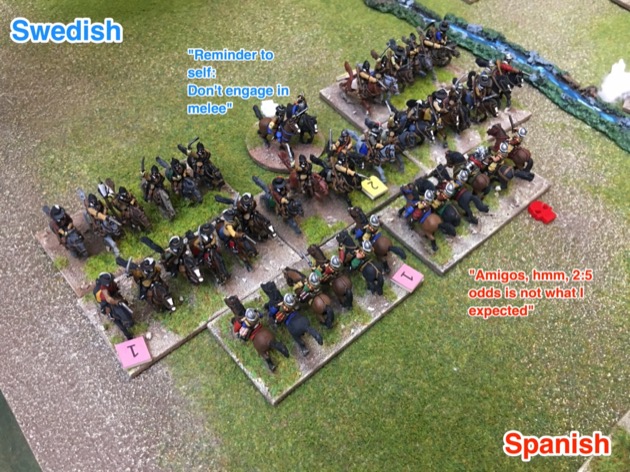
I brought up my General and my reserve horse unit.

My fresh unit, with general attached, routed a Swedish horse unit. But I lost my other unit of horse.

At this point it was hard to say who had the advantage.

There were three sub-battles in progress. I probably had a slight edge in the infantry battle in the centre and Jamie in the cavalry battle on my left. We also had a battle in the woods, where I had my dragoons. My dragoons were struggling but they had friends to help.

I brought a unit of pike+shot into the woods to confront the Swedish foot. And, where possible, I continue to charge aggressively with my infantry.

Beyond the stream my cannons finally scored their second hit on the Swedish horse in front of them, and with the loss of resolve due to the commander casualty, this unit routed. Yay for the guns.

In the last moves I routed another Swedish horse unit and Jamie made my cavalry general a casualty. Jamie had lost six units and I took the game.

Observations and conclusions
We liked quite a lot about this game. It looked great. Even though a small game it provided a lot of excitement.
Our debrief covered several points which I go through below …
Fast Play
Our last game had 26 units a side and took 3 hours and Jamie wasn’t sure this counted as “fast play”. In this game the deployment rules and movement rates meant the armies clashed together very quickly. To quote Jamie, “Small games of Tilly are definitely fast play”.
Army lists
Even with the same “army list” to choose from, and only 16 units to choose, we chose different armies. I took two cannons (versus Jamie’s one) and a dragoon where Jamie stocked up on horse. This gave Jamie a very strong cavalry wing. My selection was was supposed to give me a wing capable of operating in rough going, although this wasn’t true (see below). I see that variety as a big positive.
Terrain cards
We used Terrain Cards – Random terrain placement for pick up wargames and these seemed to work well. Jamie liked them too: “terrain placement was simple and unambiguous”.
Fighting in woods
I took dragoons to help hold any difficult terrain on a flank. But it turned out under the published rules (version 1.1), pike+shot are much better at holding rough ground than dragoons. The benefits of pike+shot are:
- Pike+shot get 4 resolve versus 3 for shot and only 2 for dragoons.
- Pike+shot benefit from the cover against shooting provided by the difficult terrain; just like shot and dragoons.
- Pike+shot can move backward 3 TUM so can fight a defensive battle; just like shot and dragoons
I’m not sure I’d do anything about the resolve thing, that still makes sense. It is what makes pike+shot so strong in the game.
But some changes are probably necessary to even up the relative value dragoons and pike+shot. Jamie suggested that pike+shot should move backward at most 1 TUM (currently the full movement rate of 3 TUM). And I think pike+shot should be disadvantaged in difficult terrain; there are several options to consider:
- get no protection from shooting when in difficult terrain (only dragoons and shot get cover)
- melee and shoot at a disadvantage in difficult terrain
- not being able to enter difficult terrain at all (except streams; what about towns/villages)
I suspect I’ll have similar issues with light horse.
Chequerboard
We tried one rule experiment to address the weakness of chequerboard deployment. Units suffered a -1d6 in melee if unsupported. Support meant a friendly unit to rear within 2 TUM. We quite liked this but thought it needed refinement. After the game we decided infantry should support infantry and cavalry should support cavalry. Cannons should always count as supported themselves, regardless of friendly troops, but should not support.
I took advantage of the allowable backwards movement to pull some of my front line pike+shot units back. I quite like this as it gave the infantry battle a bit of flow. Jamie wasn’t sure about it and, as I mentioned, suggested that pike+shot should move backward at most 1 TUM (not 3 TUM). I’m not convinced about this. I’m inclined to go the other way and let them rally back 3 TUM when they lose a melee as I’ve read multiple accounts of infantry being thrown back and returning to the fight (e.g. Swedes against Spanish fortifications at Nordlingen).
Attacker versus Defender
A couple of times Jamie has raised the possibility of distinguishing attacker and defender. Currently the trend is the other way. Introducing Terrain Cards removes a lot of the advantage of being the defender. I’m okay with that but I think Jamie is right, “Attacker” and “Defender” needs to mean something otherwise every battle is a meeting engagement.
Perhaps give the attacker extra troops in exchange for an obligation to attack. Something to think about.
Victory conditions
We played to 1/3 losses not 1/4. Worked alright. The game was slightly longer but not unpleasantly. In a game of 16 units, 1/4 is 4 units. We got there fairly quickly. 1/3 is 6 units and took another couple of turns.


There is a fairly simple way to accommodate chequer board deployment.
If the reasons for the deployment are:
A) Drill – troops moving in open files and fighting in closed.
B) Passage of lines.
C) Support.
A) Assume the base area includes the gaps or simply mandate gaps, use spacers or have a penalty if they are closed. The first is simplest.
B) Penalise like and shot units passing through, centre to centre. If the, say, middle four centimetres of a base passes through the middle four of another, both lose a point of resolve. That can be rationalised as pikes not being able to let fugitives through. That rewards an off-set deployment.
C) Keep the plusses for support and that, with the need to keep weaken ed units from being lost and adding to the army break total, gives a good reason for exchange of lines.
I’m not keen on mandating historical behaviour (in this case “gaps”). I much prefer encouraging historical behaviour. Carrot rather than stick.
Given my units are brigades they will have gaps between the component sub-units. It is the gaps between brigades that I’m thinking about.
Tilly’s Very Bad Day already forbids interpenetration of infantry units. They didn’t seem to do that.
Hi Steven,
I think John’s point makes sense and is worth pursuing, and the fix need not be seen as mandating or prescribing historical behaviour. I’ll (try to) explain.
First, it seems that the chequerboard question / discussion may be starting to run afoul of Steven’s design rule number 1 (see your response to Jurjen in the Tilly download post), vis: ‘many sets of rules out there … are confused about the scale of the game. They talk about brigades (but) …’ and your solution, which is ‘abstract up … (the) unit is a brigade and I don’t care what happens inside the brigade.
Second, your parallel topic about whether to differentiate ‘big units’ from small in Tilly can be connected with the question about chequerboard.
So here’s how (maybe).
In Tilly a brigade is a small number of units that are not (necessarily) modelled on the base but are deemed to operate and cooperate within the footprint of the base.
The sources I know (which aren’t sufficient for this discussion, I admit) seem to conceive the chequerboard formation as being connected with the adoption of smaller formations of men, around 400 – 700 strong (commonly called ‘battalia’, at least by wargamers). In that conception, the battalia operate in two lines with the units of the second line deployed opposite the gaps in the first line. I don’t get the impression that there was any ‘second order’ chequerboard arrangement at the brigade level.
If that’s true then modelling the chequerboard on the table in TVBD is perhaps at best a visual artifice or perhaps a reminder to employ a particular mechanism during the combat phase. I don’t think its necessary to model it explicitly and I wonder if it detracts, on the whole. It’s bound to exacerbate the inevitable distortion that always occurs in respect of unit depths by comparison with frontage. Maybe it would be best to deem that the ‘standard’ brigade, as originally conceived in the design, is operating in chequerboard.
But so what? And why? Well maybe we find the reason as part of considering the question of whether to model bigger units.
First let’s go back to rule number 1. In TVBD all brigades are roughly numerically equal in ‘strength’. Each represents something like 2000 men. (I know you know this – bear with me.) Base frontage is always the same and that’s probably realistic anyway. Base depths are almost certainly quite overscale.
Now consider rule number 2, vis ‘… this was a formation, and common, but the combatants of the period used many others …’.
So there’s no reason why you can’t define one type of infantry brigade as representing 3 – 5 small battalia operating, or able to operate, in chequerboard and another type as representing 2 larger units (or possibly even 1 very large unit) that aren’t operating (and maybe can’t operate) in chequerboard. And there’s no reason to model this difference explicitly on the base, apart from the (admittedly pretty crucial) ‘look and feel’ of the thing and as an aide memoire. (I prefer to model the difference but there’s a cost in money and painting time – my own units are set up to deploy 50% more figures for the larger units in a deeper formation on a slightly wider frontage.)
And the practical difference between these two types could be …
The brigade-with-battalia has the standard level of resolve but can carry out a ‘passage of lines’ manoeuvre with an identical unit lined up directly in front of or behind it provided neither are in combat or, where the lead (front) unit is in combat, by that unit performing a Rally Back manoeuvre along the lines of that described in para 3.5.
The brigade-with-big-units has an enhanced level of resolve but can never carry out a ‘passage of lines’ manoeuvre.
So, well, there you are, that’s it. Sorry it’s such a long post. Hope there’s something helpful in it.
Best regards,
Chris
> First, it seems that the chequerboard question / discussion may be starting to run afoul of Steven’s design rule number 1 (see your response to Jurjen in the Tilly download post), vis: ‘many sets of rules out there … are confused about the scale of the game. They talk about brigades (but) …’ and your solution, which is ‘abstract up … (the) unit is a brigade and I don’t care what happens inside the brigade.
This is partly about the component parts of a brigade (‘battalia’ to adopt your term) and their relationship with each other, and partly the arms and their relationships.
Firstly the component parts of a ‘brigade’. The component parts of a Spanish squadron (aka brigade) were divided by equipment i.e. a block of pikes, several blocks of musketeers, several blocks of arquebusiers. The component parts of a Swedish brigade (or Dutch or …) were ‘batalia’ including both pike and shot.
Then the relationship between the arms. The wargamer convention is that all shot formed on the wings of the pikes. In a Swedish Brigade many of the shot were actually behind the pikes. Similarly, one of several possible Spanish formations had the shot behind the pikes. Another Spanish formation had all of the shot to the front and yet another matched the wargaming convention.
The Swedish brigade highlights that the brigade structure is dependent on combining these two things. The arms of the lead ‘batallia’ of a Swedish brigade were organised differently to those behind. The total effect, if you look at the arms within the brigade, is very complicated.
“Complicated” is the word. For me this is interesting as an amateur historian. But I do not think it is important for a brigade level game. 2,000 veteran Swedes were as effective as 2,000 veteran Spaniards. At least to my eyes, looking back 400 years.
> The sources I know (which aren’t sufficient for this discussion, I admit) seem to conceive the chequerboard formation as being connected with the adoption of smaller formations of men, around 400 – 700 strong (commonly called ‘battalia’, at least by wargamers). In that conception, the battalia operate in two lines with the units of the second line deployed opposite the gaps in the first line. I don’t get the impression that there was any ‘second order’ chequerboard arrangement at the brigade level.
A group of ‘Battalia’ could form chequerboard, as you describe. But they also adopted a number of other formations. And don’t forget the arrangement of the arms within a ‘battalia’ could differ within a brigade (e.g. Swedish Brigade). This is the bit I make no attempt to simulate in Tilly’s Very Bad Day, which is what you suggest.
But brigades could also formed chequerboard. Swedish Brigades, for example, formed in chequerboard i.e. two lines of brigades with the rear brigades lined up to gaps in the front brigades. “Tercios” could also do this. Similarly brigades could form a (more or less) single line. Generals had a lot of choice.
In short, yes, there was a ‘second order’ chequerboard arrangement at the brigade level. And this is the one I’m talking about for Tilly’s Very Bad Day.
I am enjoying reading your game reports and testing of new rule mechanisms. An interesting question about expectations of fast play rules.
Although both contemporary and modern depictions vary greatly in terms of ‘unit density’, I think this looks like a battle should look!
Richard, in our off-line discussion we have talked about the “feel” of a game. I think “look” is equally important. If games of Tilly’s Very Bad Day look like paintings of Thirty Year War battles, then I think I’ve done a good job.